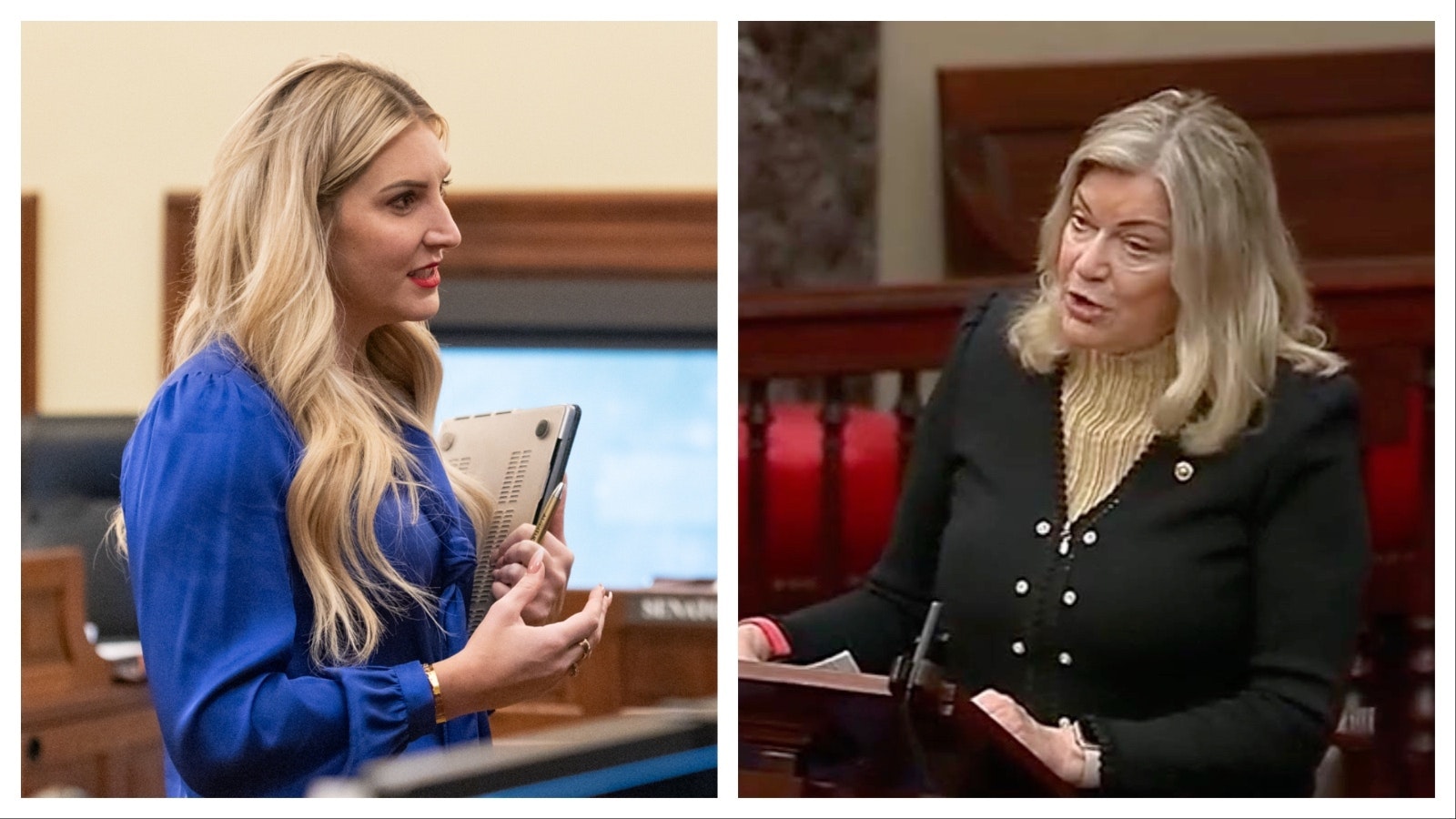Sheridan County Democrats are threatening to sue the state over the way the Legislature adjusted its House and Senate districts earlier this year.
Claims of underrepresentation in both Sheridan and Johnson counties have the party ready to take legal action to challenge the plan approved just this spring, said David Myers vice chair of the Sheridan County Democratic Party.
“I hope we made it really clear the status quo is not good enough for us,” Myers said. “Every voter is underrepresented in Sheridan and Johnson counties.”
Lower Level of Representation
The county party’s frustration with the reapportioned map passed by the Wyoming Legislature this spring pertains to the fact that multiple House and Senate districts in Sheridan and Johnson counties have fewer legislators representing more people than other counties in the state — meaning a lower level of representation.
Although the difference is small, opponents maintain it may violate the Wyoming Constitution’s Equal Protection Clause and the concept of one-person, one-vote.
In Wyoming, two House districts are typically placed within the boundaries of one Senate district in each county, a process known as “nesting.” In Sheridan County, the House and Senate districts are mostly separate.
“Backroom Dealing”
Myers said this occurred as a result of “backroom dealing” on the part of State Sens. Bo Biteman, R-Ranchester and Dave Kinskey, R-Sheridan.
Myers said he would like to see the three House districts in Sheridan County redrawn so they are nested in a Senate district.
These are the only districts in the state that aren’t nested. There are no state laws requiring nesting. Neither Biteman or Kinskey responded to requests for comment.
Rep. Mark Jennings, R-Sheridan, said he did not believe the plan as approved by the Legislature will result in any problems.
“I don’t think it will cause any problems as there have been other un-nested districts around the state and I am not aware of any problems,” he said.
Voter Confusion
Myers and Rep. Mike Yin, D-Jackson, said un-nested districts an lead to voter confusion about who their elected officials are. Yin said having nested districts is valuable because it allows legislators to collaborate with their nested counterparts in the Senate and House.
Sheridan and Johnson counties are also the only counties that have legislative districts with a deviation from ideal representation levels higher than 5%.
Courts have ruled that each House and Senate district in a state must contain about the same number of people — within 5% of the ideal.
In Sheridan and Johnson counties, six of the legislative districts exceed the allowed deviation — five by a fraction of a percent and one by slightly more than 1%.
There are other states like West Virginia and Hawaii that have districts much more out deviation. Districts in Hawaii are off by as much as 6%.
Jennings said the lines were drawn the way they were to balance out populations in House Districts 40 and 51. This resulted in the town of Story, a small rural community boasting a population of 805, continuing to be incorporated into Biteman’s district.
Jennings said Story had been included with Johnson County’s House district in the past and the small level of deviation infraction made it not worthwhile to look at redrawing the maps.
Four Redistricting Lawsuits
There have been four redistricting lawsuits in Wyoming history and the decisions in each case have gone against the plan initially developed and adopted by the Legislature.
In a 1991 redistricting battle, the Wyoming Supreme Court ruled that legislative districts must have equitable voting power and rejected the map approved by Wyoming lawmakers as unconstitutional.
The state’s most recent redistricting process was a long and arduous one that legislators worked on from late 2021 through the spring legislative session.
An out-of-deviation map that kept all districts nested while adding three new seats to the Legislature made it through the Corporations, Elections and Political Subdivisions Committee and the House, but died in the Senate, Myers and Yin said, partially due to a lack of cooperation from the Sheridan and Johnson county senators.
Rep. Barry Crago, R-Buffalo, said the original plan that came out of the House may have had nested districts, but also would’ve have caused out-of-county representation, with people from Sheridan County represented by senators in Campbell and Crook counties.
But this plan was out of deviation and would have caused voters in Claremont and Arvada to be represented by a representative from Campbell County.
Myers said the final map presented to the Legislature after the rejection of the earlier version was the result of backroom dealing.
A final version of the map was submitted to both chambers of the Legislature late on the final day of the session, with final approval coming at 10 p.m.
No Backroom
Jennings said there were no closed-door negotiations he was aware of, just the typical give-and-take of legislative negotiations.
“There were negotiations between the House and the Senate positions as is common practice for redistricting,” Jennings said. “As far as to the negative connotation of backroom deals, I was not privy to those occurring.”
Myers said the final redistricted map reflects gerrymandering, a practice of drawing a legislative district to give one party or another the advantage when it comes time to elect legislators.
Myers said downtown Sheridan, an area with fewer conservative voters compared to the other parts of the county that was previously primarily represented in Senate District 21, was split in half. The same tactic took place in other cities throughout the state like Cheyenne and Laramie.
“They’re not willing to give up voters on their side of the county,” Myers said. “The standard deviation be damned.”
If a judge were to take up a potential case on redistricting, he or she would likely consider the merits of adopting the original map that passed through the House.
“I think we have a very good case,” Myers said. He said he has spoken with a number of attorneys who share the same belief.
Less Confident
Yin agrees the Sheridan Democrats have a case but Jennifer Lowe, executive director of the Equality State Policy Center, is less confident. ESPC was a major player in the redistricting work and supported the original bill that came out of the Elections Committee and House.
“In the end, we were disappointed that the final map was approved behind closed doors without public commentary, during the final hours of the 2022 budget sessions,” she said. “However, after carefully reviewing all of the maps, ESPC declined to pursue a lawsuit mainly because the deviation was fairly small and because the legislator’s have supported the changes.”
Although Gov. Mark Gordon allowed the redistricting map to become law without his signature, he said he was sure it would stand up to a legal challenge.
This spring, Myers walked back an initial threat of legal action, in hopes that lawmakers would rectify the situation with legislation in next year’s legislative session.
Myers said hope dwindled on that front after a Corporations, Elections and Political Subdivisions committee meeting was held last week, when the party’s threats of legal recourse were addressed and no committee member expressed any interest in taking up legislation to address Myers’ concerns.
“It is the role of the state to defend the redistricting plan more vigorously,” said Rep. Dan Zwonitzer, R-Cheyenne, chair of the House Corporations, Elections and Political Subdivisions Committee.
Lack Of Interest
Myers said he found the lack of interest troubling.
Yin said he is considering legislation that would solely address the issue of un-nested districts in Sheridan County.Yin said he believes by handling the issue of nested districts, it would by virtue make the deviation flaw “sort of nullified.”
Sen. Cale Case, R-Lander was the only member of the Elections committee to express support for a potential lawsuit from the Sheridan Democrats, but made no commitment to drafting any legislation.
“I would sympathize with their thoughts,” he said. “This is not our redistricting plan again. I believe we should have a plan in development and wish them well in their lawsuit.”
It would not be until the 2024 election that any new map would go into effect. This technically gives lawmakers until their 2024 spring legislative session to tackle the issue, but the session that year will be a shorter budget session, leaving less time to handle the matter and adding a requirement that a two-thirds majority of legislators vote for a bill’s introduction.
“Not Waiting”
That is why time may already be of the essence for people like Myers who would like to see a new map drawn. Redistricting is only required every 10 years when a new U.S. Census comes out.
“We are not waiting until the next Census,” Myers said.
Any case that may be filed would start in a district court first before moving to the Wyoming Supreme Court after what Myers said would be a likely appeal.
Yin and Myers said they would like to see an independent, nonpartisan committee determine the redistricting lines in Wyoming, but neither find this a likely scenario to occur.
“It’s hard to believe a super majority Republican legislature would give up the ability to draw their own district’s lines,” Myers said.





